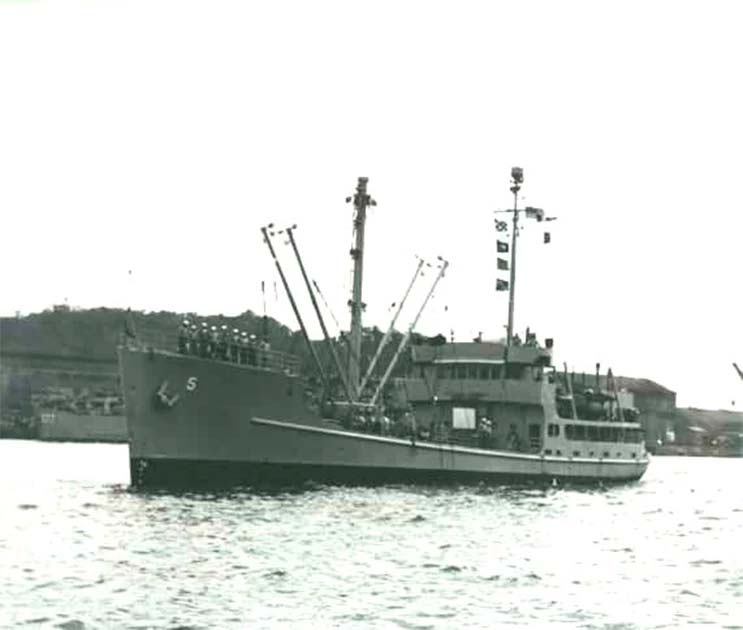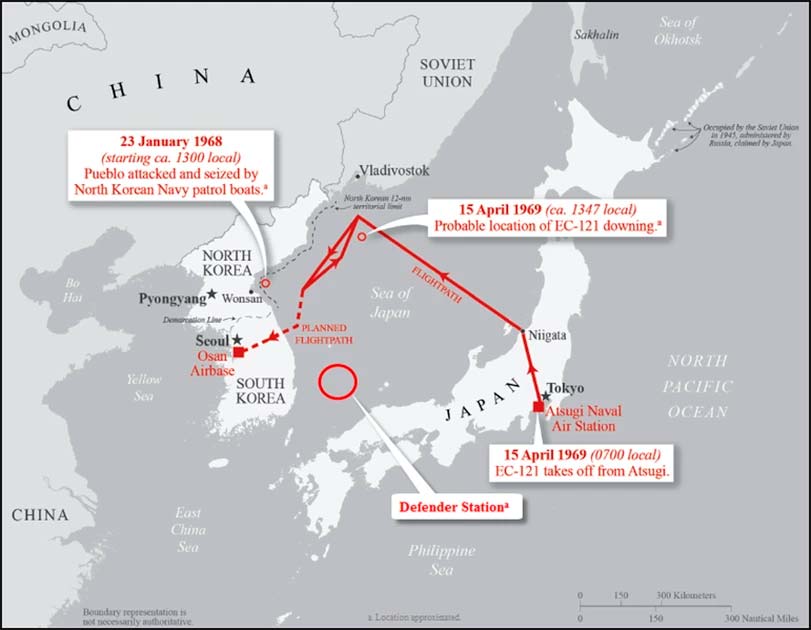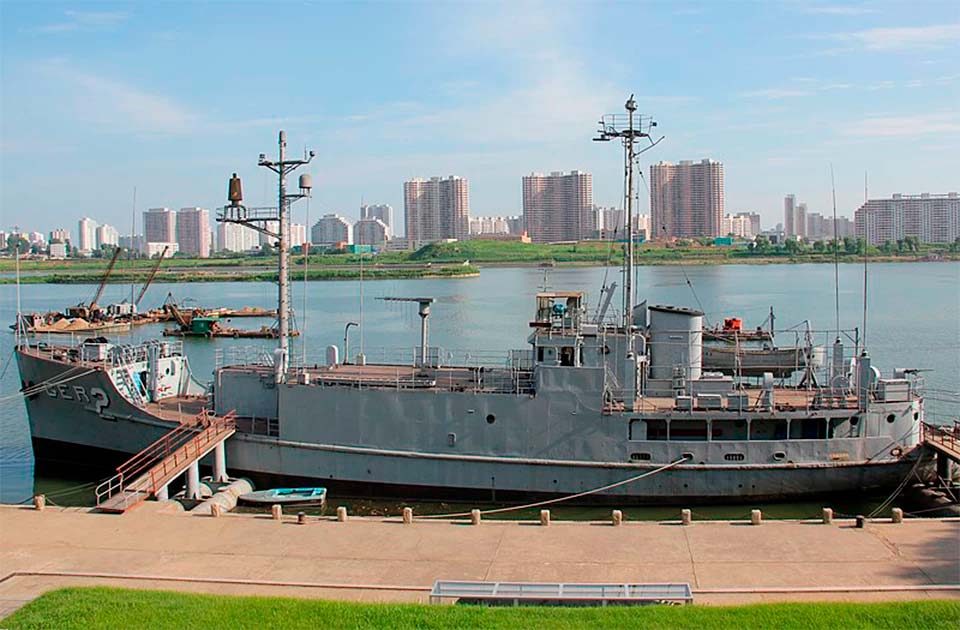The United States has the largest and most powerful navy in the world, and this navy has had a long and illustrious history. From the first ships pressed into service against the British in the 17th century to the latest generation of aircraft carriers the size of a small city, there have been many moments of glory and tragedy.
Some ships are more important than others, as is inevitable and if a ship is particularly significant the navy will retain her as a museum ship, still on the naval register and still maintained and kept in good condition. The oldest such ship is Old Ironsides herself, the USS Constitution, a three masted frigate launched in 1797 and the oldest ship afloat today.
However, the second oldest ship in the US Navy has quite a different story. The USS Pueblo is a Banner class environmental research ship, one of three commissioned in 1945. Furthermore, the USS Pueblo is not a museum ship, and in fact remains in active service.
How can the US Navy need to retain an 80 year old former cargo ship in this way?
The answer is simple. The Pueblo is the only US Naval ship to have been captured by a foreign nation.
A Dangerous Mission
USS Pueblo was launched on the 16th of April, 1944 at the Kewaunee Shipbuilding and Engineering Company in Wisconsin. It was launched as a Freight and Passenger ship for the United States Army.
It operated as FP-344 and later changed to FS-344, the change representing her role as a supply as well as a passenger vessel. On the 7th of April, 1945, the ship was commissioned in New Orleans. It became a Coast Guard-manned Army vessel that was used for providing Army training to.
Nine years later with a career of little note in 1954, FS-344 went out of service. However, this was only the start of her adventures. For the US Navy was in need of a very special class of ship, and the Banner-class vessels, all reaching the end of their lives, were seen as ideal for the task.

In the year 1966 she transferred to United States Navy and renamed as USS Pueblo. The ship was redesignated as AGER-2 on the 13th of May 1967.
The Pueblo Incident
USS Pueblo was no ordinary cargo ship. Refitted and stuffed with complex equipment, she would henceforth be a spy ship. Two years later on the 5th of January 1968, the ship left Yokosuka for Sasebo’s US naval base.
She headed northward via the Tsushima strait on the 11th of January 1968. She left with the specific aim of conducting surveillance of the activities of the Soviet Navy in the Tsushima strait and collecting electronic intelligence and signals from North Korea.
USS Pueblo carried a crew of over 80 individuals, expertly trained to operate her high-tech communication equipment. Many of the crew members onboard specialized in decoding the messages that they were hoping to intercept from the military of North Korea.
While the ship was technically trespassing in foreign waters in order to move close enough to intercept the communications chatter, it was hard for the Navy to imagine that the North Koreans would make an attempt to capture Pueblo. So, when the unthinkable took place, the crew of Pueblo were not at prepared for it.
On the 20th of January 1968, a submarine chaser of North Korea passed Pueblo at a distance of just 3.7 km (2.3 miles). Again, on the 22nd of January 1968, two fishing crawlers of North Korea named Rice Paddy 1 and Rice Paddy 2 passed within a distance of 27 m (90 feet), close enough for the crews of the vessels to hear each other.
On the 23rd of January, a submarine chaser again approached the USS Pueblo and directly challenged her nationality. In order to respond to the submarine chaser, Pueblo raised the flag of the United States.
Then the North Korean vessel ordered the ship to stand down, or they would open fire. USS Pueblo tried to escape. However, it was quite slow in comparison to the submarine chasers of North Korea.
A number of warning shots were fired. Three torpedo boats also appeared on the horizon and started chasing Pueblo. Two Air Force MiG-21 fighters even joined the chase.

The ammunition present on the USS Pueblo was stored securely below decks. The machine guns were also kept wrapped in cold-weather tarpaulins. Moreover, the machine guns were also unmanned. The the crew of Pueblo, caught flatfooted by the sudden aggression, was unable to respond to the attacks made.
The main concern of the crew was to destroy all sensitive material that was present onboard. They wanted to destroy the materials before they fell into the hands of the enemy. But they did not have any modern paper shredders. So, they tried burning the sensitive documents in metal cans or barrels, an agonizingly slow process as the Korean vessels overtook them.
- Flight 19 Disappearance: Most Likely Cause
- The 1941 Attack on Pearl Harbor: Could We Have Prevented It?
The North Koreans understood what exactly was happening on USS Pueblo. Every time they saw smoke coming out of the ship, they opened fire. Within an hour, one of the sailors was dead, and many of the crew members were injured.
Commander Lloyd Bucher, the captain of the ship, was left with no choice but to surrender. The entire crew were taken ashore and later transported to Pyongyang where they were put in jail.

The immediate concern of North Korea was to get confessions from the crew. The commander of the ship was beaten severely and forced to admit that the ship was a spy ship and had violated Korean territorial waters. Threatened by the interrogators with the torture of his crew, the commander finally gave in and had to sign the confession.
All the senior crew members of the USS Pueblo were made to sign confessions of their guilt. Later, the government of North Korea got the confessions published in order to provide justification for the capture of Pueblo. The crew members of the ship were held, and tortured, for 11 months.
A Diplomatic Disaster
USS Pueblo was taken to the Korean port of Wonsan, and the prisoners were shifted to the prisoner-of-war (POW) camps. After a lengthy period of negotiations the release of the crew was agreed and they were finally repatriated.
Once back in the States the crew members reported that they were tortured regularly and made to starve while under the custody of North Korea. Commander Bucher was tortured psychologically and stated that we resisted as long as he was able before signing the confession.
The US was forced to submit an apology along with a written admission that Pueblo was a spy ship. An assurance was also provided that the United States would not spy on North Korea in the future. Only after the admission, the government of North Korea made the decision to release the remaining 82 crew members. On the 23rd of December 1968, all captured crew members were released.
Following the release, all the officers, including Bucher, appeared before the Navy Court of Inquiry. Command Bucher was not found guilty of any kind of violation. He continued his navy career without reprimand until his retirement.
The USS Pueblo however was not given back. Until it is ever recovered, it continues to be an active ship in the US Navy. Currently, the ship is moored on Pyongyang’s Taedong River, part of the Victorious Fatherland Liberation War Museum of North Korea. It is used as a museum ship there.
Top Image: The USS Pueblo was captured by North Korea only two years after her refit as a spy ship. Source: US Navy / Public Domain.
By Bipin Dimri